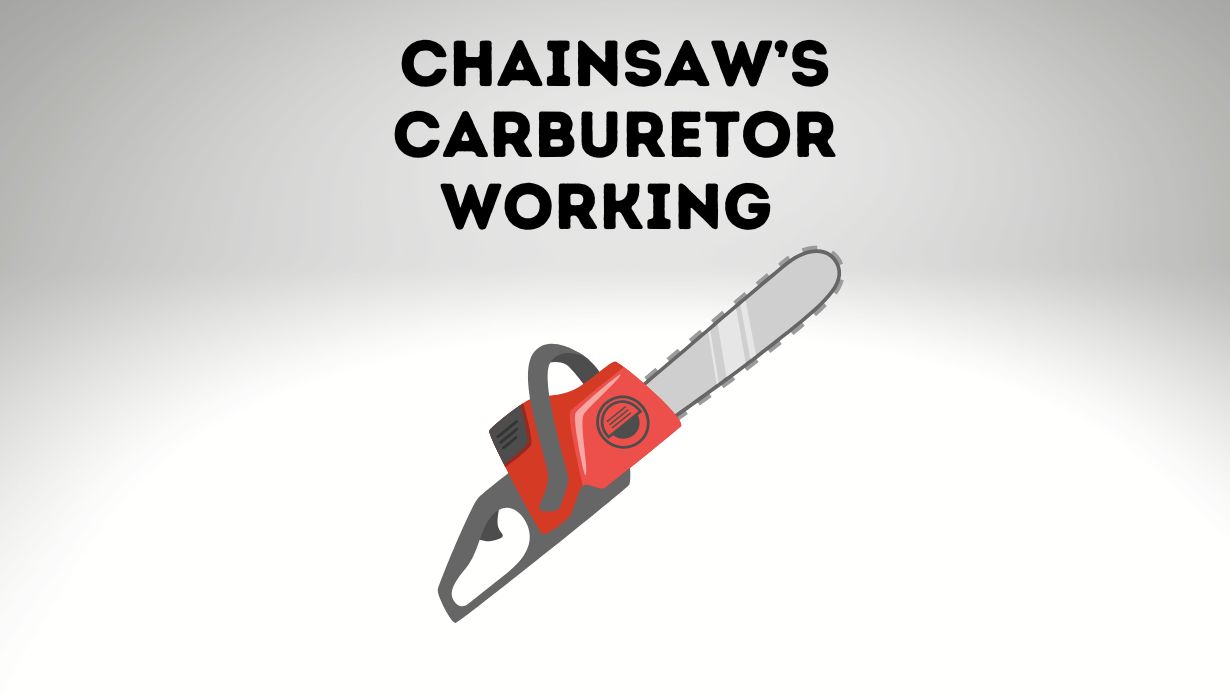
Understanding how your chainsaw works are essential for any Arborist. You can save time and money when diagnosing issues. In this article, we will look at a chainsaw’s carburetor.
You will learn all about carburetors, including:
- How they work
- What adjustments you can make to them and,
- How to tune one
What Is a Chainsaw Carburetor?
The carburetor of a chainsaw is relatively straightforward, but it still comes with its fair share of complications.
A carburetor’s job is to measure precise and small amounts of fuel. The carburetor will then mix the fuel with the air entering the engine. If this mixture isn’t perfect, the engine will run poorly.

A carburetor is a tube with an adjustable plate called the throttle plate. The throttle plate controls how much air can flow. A vacuum is generated at some point in the tube by a constriction known as the venturi. A hole in this constriction allows the vacuum to pull in fuel. This hole is named the Jet Hole.
At maximum throttle, the carburetor is working normally. The throttle plate in this example is parallel to the length of the tube, enabling optimal airflow into the carburetor. The airflow generates a good vacuum in the venturi. This vacuum sucks in a measured quantity of fuel via the jet.
The throttle plate is virtually closed when the engine is idle.
There isn’t enough air passing through the venturi to generate a vacuum. However, there is a strong vacuum on the rear side of the throttle plate since the throttle plate restricts airflow. You can pull fuel into the tube known as the idle jet by the throttle vacuum if a tiny hole is bored into the side of the carburetor’s tube.
When the engine is cold, and you try to start it with the pull-cord, it runs very low rpm. Because of this, the engine requires a very thick combination of fuel and air to start. This is when the choke plate enters the picture.
When the choke plate is engaged, it covers the venturi. The engine’s suction takes a lot of gasoline via the main jet and the idle jet when the venturi is covered. Typically, this extremely rich combination allows the engine to ignite just once or twice or to operate very slowly. When you remove the choke plate, the engine will restart properly.

What Carburetor Adjustments Are There?
On chainsaws and other two-cycle engines, carburetor adjustment is crucial.
If the adjustment is too rich, it may cause the saw to:
- Smoke
- Or have inadequate power, resulting in further carbon buildup. This buildup can harm the engine.
A lean adjustment will also create insufficient power and is more likely to harm the engine due to lean seizure.
When the quantity of fuel in the combustible air/fuel combination is so high that the fuel does not burn effectively, an over-rich carburettor adjustment is made.
The power stroke is feeble because the burn does not generate much heat. The partly burnt mixture is ejected into the muffler and is expelled as smoke from the saw.
Over-rich conditions induce carbon accumulation and, if left unchecked for an extended length of time, will clog the fire screen and cylinder ports. Aside from carburetor modifications, this can be caused by too much oil in the fuel or old stale gasoline.
When the quantity of fuel in the combustible air/fuel combination is so low that there is insufficient fuel to burn, a lean carburetor adjustment is made.
This also results in a weak power stroke and inadequate power for the saw. Aside from insufficient power, a lean state causes the cylinder temperature to increase, frequently resulting in a seizure.
Excessive RPM is also permitted in a lean situation, which frequently results in large end rod bearing failure. Other reasons for a lean running state include a shortage of oil in the fuel mix and running out of gasoline.
Always bring a saw to a halt before the tank goes dry, and make sure you use the specified gasoline: oil combination ratio for your chainsaw.
How to Tune a Carburetor
Warm-up your saw by starting it and running it for a few minutes. Set your saw down, wait 30 seconds, take it up, tip it forward, handle up, and bar down.
Tighten the screw that says low-speed to lower the quantity of gasoline entering the carburetor if it starts to stall. If the idle saw “dogs,” release the Low-Speed Screw.
This increases the amount of gasoline that enters the carburetor. Then if the idle saw “flutters” while being revved, this is excellent, but if it “screams” while revved, this is negative. So, remember to listen!
Unscrew the High-Speed Screw and you’re all done if the chain remains stationary. If the chain spins around while idle, adjust the Idler Screw as needed to halt it, but don’t panic, this problem can be solved in seconds and is highly hazardous if not corrected.
Your owner’s handbook may warn you not to adjust the carburetor without a tachometer, which helps guarantee you don’t overheat the engine.
If you have a tachometer, that’s fantastic. If not, you may still tune the carburetor using the techniques outlined above, taking care not to over-rev the engine.
Now that you know all there is to about how a chainsaw carburetor works, its parts, and adjustments, you’re more than ready to use chainsaws for your DIY projects. Just make sure you are alert and aware while using one.
